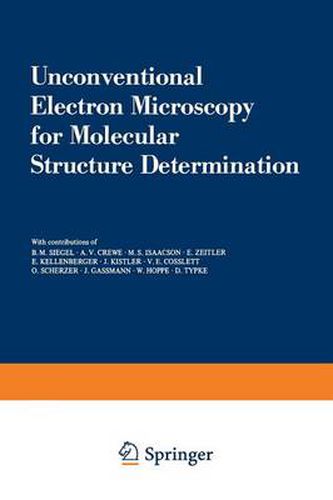Readings Newsletter
Become a Readings Member to make your shopping experience even easier.
Sign in or sign up for free!
You’re not far away from qualifying for FREE standard shipping within Australia
You’ve qualified for FREE standard shipping within Australia
The cart is loading…






This title is printed to order. This book may have been self-published. If so, we cannot guarantee the quality of the content. In the main most books will have gone through the editing process however some may not. We therefore suggest that you be aware of this before ordering this book. If in doubt check either the author or publisher’s details as we are unable to accept any returns unless they are faulty. Please contact us if you have any questions.
Generally it is not sufficiently appreciated that electron microscopy is in fact a diffraction method. In essential aspects electron microscopes are more closely related to X-ray diffracto- meters than to light microscopes. In electron microscopes monochromatized radiation and coherent illumination (never used in light microscopy) correspond in X-ray diffractometers to the primary beam with a small divergence. Imaging ina general sense can take place in interference experiments between a primary beam and a scattered beam, or between diffe- rent deflected scattered beams. This leads to the realization of an old dream in diffracto- metry, namely to a general experimental solution of the phase problem . The most im- pressive analogy, however, concerns the potential of the electron microscope as a tool for structure determination (where the radiation wavelenght is smaller than the atomic distan- ces). It was therefore considered timely to treat this topic in this series. It was a fortunate cioncidence that in 1976 a Workshop on Unconventional Electron Microscope Methods for the Investigation of Molecular Structures (sponsored by the European Molecular Biology Organisation, the Deutsche Forschungsgemeinschaft and the Max-Planck-Gesell- schaft) took place, and that most speakers presenting introductory lectures agreed to publish their contributions in an expanded version in this volume. This volume is thus not a symposium report in the usual sense since it contains the majority of these introductory lectures only.
$9.00 standard shipping within Australia
FREE standard shipping within Australia for orders over $100.00
Express & International shipping calculated at checkout
Stock availability can be subject to change without notice. We recommend calling the shop or contacting our online team to check availability of low stock items. Please see our Shopping Online page for more details.
This title is printed to order. This book may have been self-published. If so, we cannot guarantee the quality of the content. In the main most books will have gone through the editing process however some may not. We therefore suggest that you be aware of this before ordering this book. If in doubt check either the author or publisher’s details as we are unable to accept any returns unless they are faulty. Please contact us if you have any questions.
Generally it is not sufficiently appreciated that electron microscopy is in fact a diffraction method. In essential aspects electron microscopes are more closely related to X-ray diffracto- meters than to light microscopes. In electron microscopes monochromatized radiation and coherent illumination (never used in light microscopy) correspond in X-ray diffractometers to the primary beam with a small divergence. Imaging ina general sense can take place in interference experiments between a primary beam and a scattered beam, or between diffe- rent deflected scattered beams. This leads to the realization of an old dream in diffracto- metry, namely to a general experimental solution of the phase problem . The most im- pressive analogy, however, concerns the potential of the electron microscope as a tool for structure determination (where the radiation wavelenght is smaller than the atomic distan- ces). It was therefore considered timely to treat this topic in this series. It was a fortunate cioncidence that in 1976 a Workshop on Unconventional Electron Microscope Methods for the Investigation of Molecular Structures (sponsored by the European Molecular Biology Organisation, the Deutsche Forschungsgemeinschaft and the Max-Planck-Gesell- schaft) took place, and that most speakers presenting introductory lectures agreed to publish their contributions in an expanded version in this volume. This volume is thus not a symposium report in the usual sense since it contains the majority of these introductory lectures only.